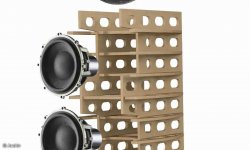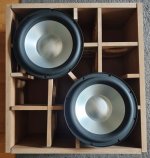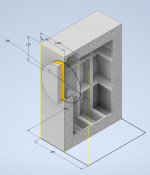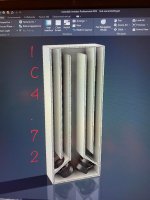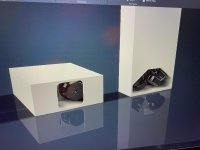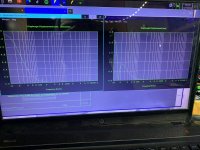For running audyssey and dsp again, I would need to go it either way as soon as I get the second driver in there.It depends on whether the chosen driver will work well enough once EQ'd in a box size that's the mean between the two optimums, i.e. 0.707x the optimal single driver box Vb, where 'optimal' is whatever size one can tolerate.
That said, the divider makes for some additional bracing, so seems the best overall choice. 😉
Either way, when you do get the 2nd one you'll need to run Audyssey and the amp's DSP again.
In there of bracing, if I go 1x 5ft^3 I could put it in the middle anyway.
I’m sorry but I’m not sure to understand the first thing you said. whats Vb? What I understand is I should aim for the closet I can get to 0.707 in a ~2.5 ft^3 per driver.
And make 2 box for 2 drivers.
Sure, as long as it's acoustically transparent enough. Historically, speaker cloth wasn't, so used to fine tune/'voice' the speaker and why they historically had so little internal damping plus needed to be both child, pet, weather resistant, though in more recent decades, high(er) end systems have preferred not to, so I've used/recommended pet screen tightly stretched over a Velcro tabbed removable frame or encased/stapled the speaker in whatever stretchable material preferred and added decorative (removable) top/bottom plates.Also, in order to hide the driver from my 1yo little finger.
Would a « conventional » cloth grill would be okay? Do’s and don’t to know when it come to grill?
Could I make clear acrylic with a pattern in it like I did with my Criton?
Gotcha, so clear acrylic with laser cut pattern isnt a good option!Sure, as long as it's acoustically transparent enough. Historically, speaker cloth wasn't, so used to fine tune/'voice' the speaker and why they historically had so little internal damping plus needed to be both child, pet, weather resistant, though in more recent decades, high(er) end systems have preferred not to, so I've used/recommended pet screen tightly stretched over a Velcro tabbed removable frame or encased/stapled the speaker in whatever stretchable material preferred and added decorative (removable) top/bottom plates.
I’ve use magnet to secure the grill on my criton. Give a clean look, but might not be strong enough for 15in woofers.
I should test how strong they are. Maybe doubling the amount of magnet would do it. But I like the little Velcro dot. And very cheap too. The screen is a good idea too.
This you see my reply to your answer from earlier about box volume, 0.707 and driver Vb’s ?!
This is for a closed box: The larger the box, the closer it's qtb will be to the chassis free air qts. You adjust it by choosing the matching volume. In times of DSP's and cheap amp power this has become a little less important. The smaller the volume, the more power is needed to drive the cone at lowest frequency's. Usually a qtb of 0.5-0.8 is a good range for a first guess.
If you go for the Dayton 15-um22, 4-5 sq feet should work well.
You should fill the whole volume with Rockwool, this will give you a virtually larger volume, about 10%.
You are building a large box, do not take thick, heavy wood, but stay reasonable and brace it from the inside. 3/4" Ply or MDF is enough. There are many ways to brace a cabinet, I prefer a matrix made from 2-3" high stripes of wood. Braced right a cabinet will sound "dead" if you knock at it, which results in a "dry" bass.
Volume is not critical with closed constructions using a DSP. Your measurements seem to show a good listening room, something I would expect from an irregular, open area as you described it. You see how low the room plays with your "small" sub. Imagine what you can expect from a 15" sub...
If you go for the Dayton 15-um22, 4-5 sq feet should work well.
You should fill the whole volume with Rockwool, this will give you a virtually larger volume, about 10%.
You are building a large box, do not take thick, heavy wood, but stay reasonable and brace it from the inside. 3/4" Ply or MDF is enough. There are many ways to brace a cabinet, I prefer a matrix made from 2-3" high stripes of wood. Braced right a cabinet will sound "dead" if you knock at it, which results in a "dry" bass.
Volume is not critical with closed constructions using a DSP. Your measurements seem to show a good listening room, something I would expect from an irregular, open area as you described it. You see how low the room plays with your "small" sub. Imagine what you can expect from a 15" sub...
Wouldn't be my choice.Gotcha, so clear acrylic with laser cut pattern isnt a good option!
I’ve use magnet to secure the grill on my criton. Give a clean look, but might not be strong enough for 15in woofers.
This you see my reply to your answer from earlier about box volume, 0.707 and driver Vb’s ?!
I recently experimented with some 1" neodymium discs and while I didn't test it with any speaker grills have no doubt that you best have a truly rigid grill frame if you expect to get it off in one piece, so recommend at least 3/4" BB, marine or similar grade plywood plates for grill construction.
Not really since they will be EQ'd to a 'fare thee well'........... HR simmed 'FR' overlay of one in 5 ft^3 (light line), dual in 2.5 ft^3 net (less driver/s and only slightly different once bracing is deducted)
Attachments
Ok. So just to be sure I understand well, again.Wouldn't be my choice.
I recently experimented with some 1" neodymium discs and while I didn't test it with any speaker grills have no doubt that you best have a truly rigid grill frame if you expect to get it off in one piece, so recommend at least 3/4" BB, marine or similar grade plywood plates for grill construction.
Not really since they will be EQ'd to a 'fare thee well'........... HR simmed 'FR' overlay of one in 5 ft^3 (light line), dual in 2.5 ft^3 net (less driver/s and only slightly different once bracing is deducted)
You still recommend of building a single 5ft^3 box.
How do you know that you have enough bracing?This is for a closed box: The larger the box, the closer it's qtb will be to the chassis free air qts. You adjust it by choosing the matching volume. In times of DSP's and cheap amp power this has become a little less important. The smaller the volume, the more power is needed to drive the cone at lowest frequency's. Usually a qtb of 0.5-0.8 is a good range for a first guess.
If you go for the Dayton 15-um22, 4-5 sq feet should work well.
You should fill the whole volume with Rockwool, this will give you a virtually larger volume, about 10%.
You are building a large box, do not take thick, heavy wood, but stay reasonable and brace it from the inside. 3/4" Ply or MDF is enough. There are many ways to brace a cabinet, I prefer a matrix made from 2-3" high stripes of wood. Braced right a cabinet will sound "dead" if you knock at it, which results in a "dry" bass.
Volume is not critical with closed constructions using a DSP. Your measurements seem to show a good listening room, something I would expect from an irregular, open area as you described it. You see how low the room plays with your "small" sub. Imagine what you can expect from a 15" sub...
I’m supposed to make laser cut test next week, but I aim to laser cut all the 3/4in birch plywood pannel. I would also cut the bracing. Are there some rule or maximum distance between brace? Or like % of box volume in braces?
Do you have a picture of a “matrix” with your preferred type of bracing?
Planning to build it with 3/4in birch plywood.
When you say don’t use thick heavy wood, you mean like actual real lumber?
Also, I gues the answer is yes, but is it a good thing to have a “dry” bass? Like it’s less boomer and muddy and clean and more enjoyable?!
So many things to learn for sure!
No, my first response you just quoted was technically wrong, so corrected it in the following 'edit' to show (1) and (2) in 5 ft^3 or (1) in 2.5 ft^3 implied if a divided box, which in retrospect I should have at the beginning just said divide the box in two rather than try to make it a teaching 'moment' since my sinus meds is making me a bit too 'spaced out' to think clearly enough to not make such stupid mistakes.You still recommend of building a single 5ft^3 box.
This is my "personal style" of doing it, which has been the result of some centurys of speaker building and independendly verified by DIYS publications.
There are other ways to do it, which will give compareable results, but add much more weight and cost to your build.
The best one I ever build was repurposing the concrete space of an under floor heater into a 180 liter subwoofer cabinet during a house renovation. I calculated it's weight to be about 1.2 metric ton's.
You get the picture?
Staying conventional, you often see very confusing "bracing" inside DIYS speakers, maybe the result of try and error with the error not removed, once glued in place. Others are a bare minimum, as many builders look for simple, less time consuming plans. Of course, any builder knows best and any build is just perfect... near to a religious discussion. Basically it boils down to mass versus intelligence.
You sure know what a T-bar is? The same principle can be used inside loudspeaker cabinets.
This systematic approach is to take stripes of wood ("wood" = ply, MDF, OSB, particle board or any other processed material used), the same stength of the outer wall. It's height should be about 3 times it's strength, so for 3/4" something like 2-2.5". Then you choose a matrix size. If we stay with 3/4" ply, a distance of 4" should give very good results. Modify this measure a little to fit your cabinets inside.
When the outer 5 sides of the cabinet are joined, I start with the short 4" pieces at one wall and then add the long one, oriented 90° to them, then short row 4" and so on. The last row of small bits has to be matched for tollerances.
Sure cutting anything in advance is a nice idea, but you may not be able to include the glue gap and swelling of wood to all measures.
.0001% tollerance CNCing or laser cutting find limits with a living material like wood that may change it's size by .5% in a few days. Usual pannel saw tollerance is about +- .5mm, depending on gear and operators motivation. A huge advantage is modern poluretane wood glue, which uses moisture to harden and foams up a bit, filling small gaps. Not even expensive, if you check online for pro sources. Take the large bottle for your project!
Here are pictures, one that shows the bare minimum and some over the top matrix, last what has best results. If you want, add some connection between opposing walls when practical.
There are other ways to do it, which will give compareable results, but add much more weight and cost to your build.
The best one I ever build was repurposing the concrete space of an under floor heater into a 180 liter subwoofer cabinet during a house renovation. I calculated it's weight to be about 1.2 metric ton's.
You get the picture?
Staying conventional, you often see very confusing "bracing" inside DIYS speakers, maybe the result of try and error with the error not removed, once glued in place. Others are a bare minimum, as many builders look for simple, less time consuming plans. Of course, any builder knows best and any build is just perfect... near to a religious discussion. Basically it boils down to mass versus intelligence.
You sure know what a T-bar is? The same principle can be used inside loudspeaker cabinets.
This systematic approach is to take stripes of wood ("wood" = ply, MDF, OSB, particle board or any other processed material used), the same stength of the outer wall. It's height should be about 3 times it's strength, so for 3/4" something like 2-2.5". Then you choose a matrix size. If we stay with 3/4" ply, a distance of 4" should give very good results. Modify this measure a little to fit your cabinets inside.
When the outer 5 sides of the cabinet are joined, I start with the short 4" pieces at one wall and then add the long one, oriented 90° to them, then short row 4" and so on. The last row of small bits has to be matched for tollerances.
Sure cutting anything in advance is a nice idea, but you may not be able to include the glue gap and swelling of wood to all measures.
.0001% tollerance CNCing or laser cutting find limits with a living material like wood that may change it's size by .5% in a few days. Usual pannel saw tollerance is about +- .5mm, depending on gear and operators motivation. A huge advantage is modern poluretane wood glue, which uses moisture to harden and foams up a bit, filling small gaps. Not even expensive, if you check online for pro sources. Take the large bottle for your project!
Here are pictures, one that shows the bare minimum and some over the top matrix, last what has best results. If you want, add some connection between opposing walls when practical.
Attachments
I disagree about using Rockwool, as it takes away volume being a solid compressed brick. It is good for absorbing like a black hole, but not better for open cell damping.
Ultimax drivers really were not designed for vented boxes, but for sealed and possibly with supplied boost.
I think 2 woofers in opposed-vibration facing each other cabs will:
Protect drivers easier by slot exits on both sides.
Reduce vibration of subwoofer to prevent walking of sub across floor.
Increase output over a single driver.
Ultimax drivers really were not designed for vented boxes, but for sealed and possibly with supplied boost.
I think 2 woofers in opposed-vibration facing each other cabs will:
Protect drivers easier by slot exits on both sides.
Reduce vibration of subwoofer to prevent walking of sub across floor.
Increase output over a single driver.
Sorry, the "Rock Wool" you mention seems to be another quality than that what I and the loudspeaker industry use.
Inside the sub woofer the speed of sound is slowed down in this loosely packed material, which results in a measurable lower resonance frequency of the closed box. Damping is a side effect in this use.
You do not stuff it inside with force, but fill it very gently compressed. This has been done for ages and the effect is not a matter of discussion.
"Glass wool", even as mentioned quite often, is not suited for this task and confused with "Rock wool", which stands for a mineral wool made from basalt or dolomite.
If you want to damp out resonances in vented cabinets, you will not use rock wool, as it may disperse it's fibers into the room. Even as these are non toxic, we are concerned about any foreign matter in our living space.
Here the usual material of choice is acrylic wool, as you will find it in a pillow. Indeed there is a cheap IKEA pillow, which is very often used for this task. Of course any cheap material designated to DIYS suddenly gets extremely expensive... so IKEA saves you quite some money filling your speaker.
There are many other products of this kind, promoted to improve the sound of speakers. In most cases very cheap if used in buildings, renovating, insolating,and huge amounts. Then offered as special quality, from a "speaker shop", costing ten or twenty fold. Don't get fooled, there is hardly any product made soley for speakers, just matching industry products rebaged.
Like bitumen, which is dead cheap as roofing felt.
As a general rule, gluing or nailing something to the inside of a speaker cabinet may be useful, while in a sub woofer it is wasted time and money. Such viscous elastic stuff like bitumen work well for higher frequency, but do not effect low ones.
You may have noticed the effect when you hear the bass even outside a concert venue, but any higher frequency is blocked from walls and windows.
Inside the sub woofer the speed of sound is slowed down in this loosely packed material, which results in a measurable lower resonance frequency of the closed box. Damping is a side effect in this use.
You do not stuff it inside with force, but fill it very gently compressed. This has been done for ages and the effect is not a matter of discussion.
"Glass wool", even as mentioned quite often, is not suited for this task and confused with "Rock wool", which stands for a mineral wool made from basalt or dolomite.
If you want to damp out resonances in vented cabinets, you will not use rock wool, as it may disperse it's fibers into the room. Even as these are non toxic, we are concerned about any foreign matter in our living space.
Here the usual material of choice is acrylic wool, as you will find it in a pillow. Indeed there is a cheap IKEA pillow, which is very often used for this task. Of course any cheap material designated to DIYS suddenly gets extremely expensive... so IKEA saves you quite some money filling your speaker.
There are many other products of this kind, promoted to improve the sound of speakers. In most cases very cheap if used in buildings, renovating, insolating,and huge amounts. Then offered as special quality, from a "speaker shop", costing ten or twenty fold. Don't get fooled, there is hardly any product made soley for speakers, just matching industry products rebaged.
Like bitumen, which is dead cheap as roofing felt.
As a general rule, gluing or nailing something to the inside of a speaker cabinet may be useful, while in a sub woofer it is wasted time and money. Such viscous elastic stuff like bitumen work well for higher frequency, but do not effect low ones.
You may have noticed the effect when you hear the bass even outside a concert venue, but any higher frequency is blocked from walls and windows.
Attachments
Last edited:
The mentiones Ultimax drivers are more on the side of equalized, closed cabinets, that is right. On the other side, when the much larger volume is acceptable, vented they work just as well and gives about 4dB higher output in the low end. Theorie expects +6dB but no mechanical system works without losses. Anyway this is very respecable and the higher output doesn't need more amplifier power. The worse impulse behavior and group delay are more a case for academic discussion than practical relevance. When the listening room is finished with bending the sub's output, there usually is not much left of these advantages.
This is for a sub woofer! Smaller drivers may in fact profit from the closed construction concerning these parameters.
Two drivers on opposing sides of a cabinet are much better than a single driver. Sure!
If one can afford the cost and space, this should be considered. The moving mass of the cones, which can even moves large sub woofer on the floor at high levels, is completely canceled out. The cabinet is resonating much less. This has a hear able effect.
Having the cones left an right may even be an design advantage, if WAF is a factor. Think of a side board with an open shelf in the middle.
This is for a sub woofer! Smaller drivers may in fact profit from the closed construction concerning these parameters.
Two drivers on opposing sides of a cabinet are much better than a single driver. Sure!
If one can afford the cost and space, this should be considered. The moving mass of the cones, which can even moves large sub woofer on the floor at high levels, is completely canceled out. The cabinet is resonating much less. This has a hear able effect.
Having the cones left an right may even be an design advantage, if WAF is a factor. Think of a side board with an open shelf in the middle.
Ignore the numbers in the green rendering on a plasma cam software …. The umax drivers thrive in 3:1 reduction MLTL. the offset entry just eases the construction in this case (and I xo point is freed up) and vent location for a simple subwoofer essentially and allows plenty of room for critically dampening, the driver and vent issues of the higher QTS ‘Spikes’ maybe?
Attachments
Last edited:
That’s good teaching something for the young one.No, my first response you just quoted was technically wrong, so corrected it in the following 'edit' to show (1) and (2) in 5 ft^3 or (1) in 2.5 ft^3 implied if a divided box, which in retrospect I should have at the beginning just said divide the box in two rather than try to make it a teaching 'moment' since my sinus meds is making me a bit too 'spaced out' to think clearly enough to not make such stupid mistakes.
So I’ll go with 2 box of 2.5ft^3
I’ll try and post on the slot loaded thread somewhere to see what they think. I’m curious.
What should I look for in the graph you linked? I’m scared I don’t see it.
Is horn resp better than winisd?
What’s eq’ed to a “far thee well” ?
What should I look for in the graph you linked? I’m scared I don’t see it.
Is horn resp better than winisd?
What’s eq’ed to a “far thee well” ?
“Fare thee well” noun. a state of perfection. The meal was done to a fare-thee-well. The maximum effect; fullest measure or extent, which in your case is the mass quantities of EQ required to change the two different box alignment speaker responses to ~flat in room, so nothing to be scared of per se, just shows how much under-damped they are that before digital EQ/DSP would perform much like a mobile audio's boombox in your HT.
The pro version of WinISD was ~ on par with the corresponding early version of HR, but no clue about more recent versions of WinISD and for sure doesn't have any of HR's many special features that allows a novice to design advanced cab alignments with its 'fill in the blanks' box/TL/horn alignment wizards.
The simulation results from both programs usually match with the simple constructions, like closed and vented. If things get more complicated, like horn, transmission line and bandpass, you will end up with hornresp. Maybe the best free program today.
That is sexy designs. Love “unusual design” like this.Ignore the numbers in the green rendering on a plasma cam software …. The umax drivers thrive in 3:1 reduction MLTL. the offset entry just eases the construction in this case (and I xo point is freed up) and vent location for a simple subwoofer essentially and allows plenty of room for critically dampening, the driver and vent issues of the higher QTS ‘Spikes’ maybe?
What’s a 3:1 reduction mltl?
What’s I xo point is freed up?
In shorts im not sur I understand all you said, English is not my first language and this hobby as a lot of technical terms.
Oh gotcha! Thanks you. Will definitely have a look at horn resp one day.“Fare thee well” noun. a state of perfection. The meal was done to a fare-thee-well. The maximum effect; fullest measure or extent, which in your case is the mass quantities of EQ required to change the two different box alignment speaker responses to ~flat in room, so nothing to be scared of per se, just shows how much under-damped they are that before digital EQ/DSP would perform much like a mobile audio's boombox in your HT.
The pro version of WinISD was ~ on par with the corresponding early version of HR, but no clue about more recent versions of WinISD and for sure doesn't have any of HR's many special features that allows a novice to design advanced cab alignments with its 'fill in the blanks' box/TL/horn alignment wizards.
- Home
- Loudspeakers
- Subwoofers
- Need help designing a home theater subwoofer
![Dayton UM18-22 overlay responses [sebr0.23].PNG](/community/data/attachments/1026/1026229-cd1b13a9ff94df0e68e3143b3b6ad4a2.jpg?hash=zRsTqf-U3w)
![Dayton UM18-22 overlay responses [sebr0.23].PNG](/community/data/attachments/1026/1026281-4a5b29ec83419d7f7030bf3ab5f9f3cf.jpg?hash=Slsp7INBnX)
